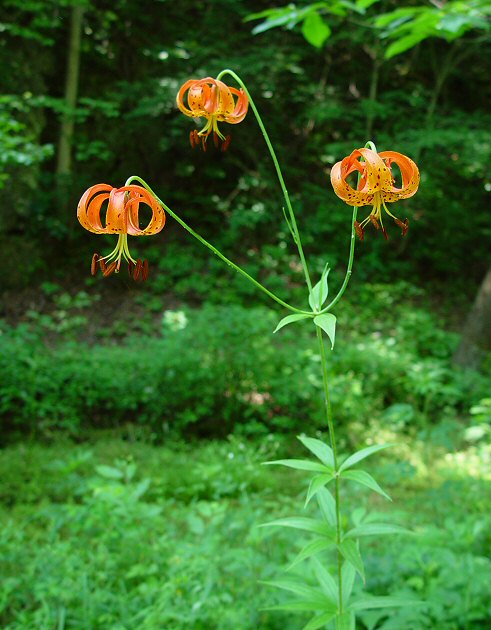Lilium michiganense Farw.
Michigan Lily

Native
CC = 7
CW = -3
MOC = 30
© DETenaglia
Lilium michiganense Farw.Michigan Lily | |
 |
Native CC = 7 CW = -3 MOC = 30 |
© DETenaglia |
|
Family - Liliaceae Habit - Perennial forb from a stout, scaly, light yellow bulb. Stems - Flowering (aerial) stems ascending to erect, to 2 m, green, glabrous, glaucous.
Leaves - Typically whorled, sometimes alternate at the lowermost or uppermost nodes, to 12 cm long, 5 cm broad, lanceolate to elliptic, tapered at both ends, glabrous above. Undersurface and margins roughened with minute, toothlike processes along the margins and the veins.
Inflorescence - Terminal whorls of 2-5 flowers (more in cultivated plants), often reduced to a single flower. Flowers nodding, the long stalks bent abruptly near the tips.
Flowers - Perianth (tepals) 6, mostly red with a yellow base and brown speckles, recurved, to 10 cm long, with a green area (the nectary) 5-12 mm long at the base. Stamens 6, exserted well beyond perianth, the anthers 5-15 mm long. Style 1. Stigma 3-lobed.
Fruits - Barrel-shaped or ellipsoid capsules 3.0-4.5 cm long. Flowering - June - July. Habitat - Mesic bottomland to upland forests, streambanks, mesic upland to wet bottomland prairies, bluff ledges, roadsides, railroads. Frequently cultivated. Origin - Native to the U.S. Lookalikes - L. superbum. Other info. - This is an easily recognized lily which is often cultivated. Horticultural forms may vary in perianth color and number of flowers terminating the stem. This is the most common species of Lilium found in the state, occurring in a number of widely scattered counties. Elsewhere its range is mainly within the U.S. upper Midwest. Photographs taken at Pultite Spring, Shannon County, MO., 6-27-04 DETenaglia); also at Shaw Nature Reserve, Franklin County, MO, 6-22-2007 and 6-30-2017, and Glassberg Conservation Area, Jefferson County, MO, 4-30-2020 (SRTurner); also in St. Louis, St. Louis County, MO, 10-23-2022 (KBildner). |